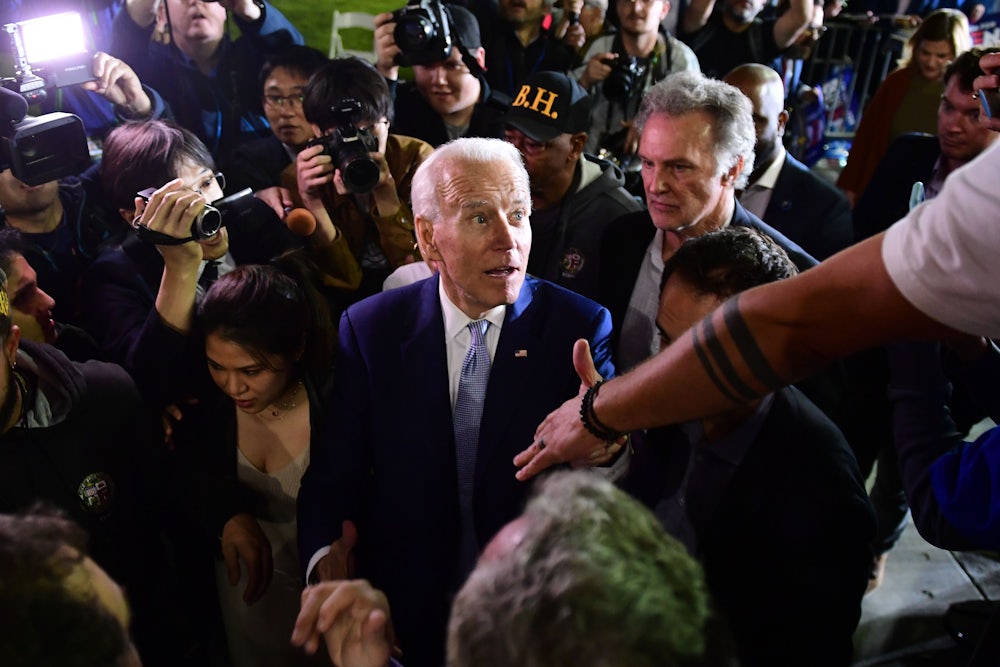It feels safe at this point to call yesterday both an incredible Super Tuesday for Joe Biden’s campaign and one of the most remarkable days in the history of modern presidential politics. Biden, whose campaign had been declared all but dead after Bernie Sanders’s victories in New Hampshire and Nevada and steady rise in polls nationwide, won nine states and could well pick up another once all the results from Maine, a state where Sanders was expected to do well but underperformed, are in. Those already in Biden’s column include, in addition to a full sweep of yesterday’s southern contests, Elizabeth Warren’s home state of Massachusetts; Amy Klobuchar’s home state of Minnesota; and Texas, where Sanders had led polls. Sanders managed to secure victories in all the states where he’d been heavily favored to win: his home state of Vermont, Colorado, Utah, and the primary’s biggest prize, California.
The pledged delegate tally shows a close race. As of the early afternoon on Wednesday, Biden has 433 to Sanders’s 388, with more results to come in from Maine and California. But it’s narratives that ultimately drive primary politics, and Sanders’s defeats last night have likely made Biden the front-runner not only in the delegate count but in the minds of Democratic voters in the remaining states.
Biden’s surge back to the top began Saturday evening, with a much better than expected performance in South Carolina, which many have attributed to the endorsement of Congressman James Clyburn, effectively the head of the state’s Democratic machine. In truth, Biden was already running strong with African American voters before Clyburn spoke up, and the kind of Democrat for whom an endorsement like Clyburn’s would have mattered—almost half of the state’s voters claimed it did—were probably already favorably disposed to the former vice president. Nevertheless, media coverage of the endorsement, both inside and outside the state, framed it as extraordinarily significant: a sign that Democratic party leaders were belatedly coalescing around Biden’s candidacy.
After South Carolina, the dominoes fell quickly. Pete Buttigieg and Amy Klobuchar dropped out and endorsed Biden, as did former candidate Beto O’Rourke. All three joined Biden for a rally that was covered extensively on cable news. These were just the most noteworthy of a plethora of endorsements Biden racked up right before Super Tuesday. Collectively, they have breathed new life into the thesis of the widely discussed 2008 book The Party Decides, which holds that it is ultimately the leadership and major figures of political parties who deliver nominations. But there was about as much evidence in the events that followed South Carolina that it’s actually the media that decides—that the press broadly speaking, and cable news in particular, having already put electability front of mind among the Democratic electorate, have reshuffled Democratic politics once again through the momentum-generating role they have always played in staggered primaries.
The message broadcast to Democratic voters nationwide in the three days after South Carolina was clear: Biden is back. It was heard loud and clear, even in states like Vermont where he’d invested few resources and even less attention but surpassed expectations. Across the map, Biden handily won voters who’d only recently decided on a candidate. A strong performance among late deciders, even in the Hispanic electorate that Sanders has done particularly well with, likely helped him carry Texas.
Biden was also boosted by huge jumps in turnout, contrary to conventional wisdom that was already eroding before voters went to the polls on Tuesday. In Virginia, one of many states where Biden outperformed good expectations, turnout nearly doubled from the 2016 primary, owing largely to the participation of energized suburban moderates, with whom Biden performs well. These voters, in fact, are likely why Biden won nearly 60 percent of the new voters across the Super Tuesday states, according to The Washington Post.
Biden also continued to do very well with black voters, who brought him decisive victories across the South. Sanders’s weakness among African Americans, which mirrors his performance in 2016, is perhaps the most daunting challenge facing his campaign. But there are others. An expected surge in youth turnout has failed to materialize. The voters who are turning out are both deeply focused on beating Donald Trump and deeply attuned to conventional media narratives about how to do so. And while assembling a coalition of progressives, Hispanics, young voters of all races, and some white working-class voters might have been enough to establish a plurality in a field with multiple moderates, it plainly isn’t a sizable enough coalition to win a true two-man race against Biden, who has rapidly consolidated the Democratic rank and file.
Sanders will have to rethink the first principles of his approach and do it fast. The next set of primaries begins in less than a week, and several states on the upcoming calendar look like favorable terrain for Biden. An earned media gambit of some kind could sideline Biden’s narrative enough to keep Sanders competitive and buy the campaign enough time to return to the drawing board. But absent a major reassessment of the race and some creative thinking on their part, Biden will be well on his way to the nomination.
